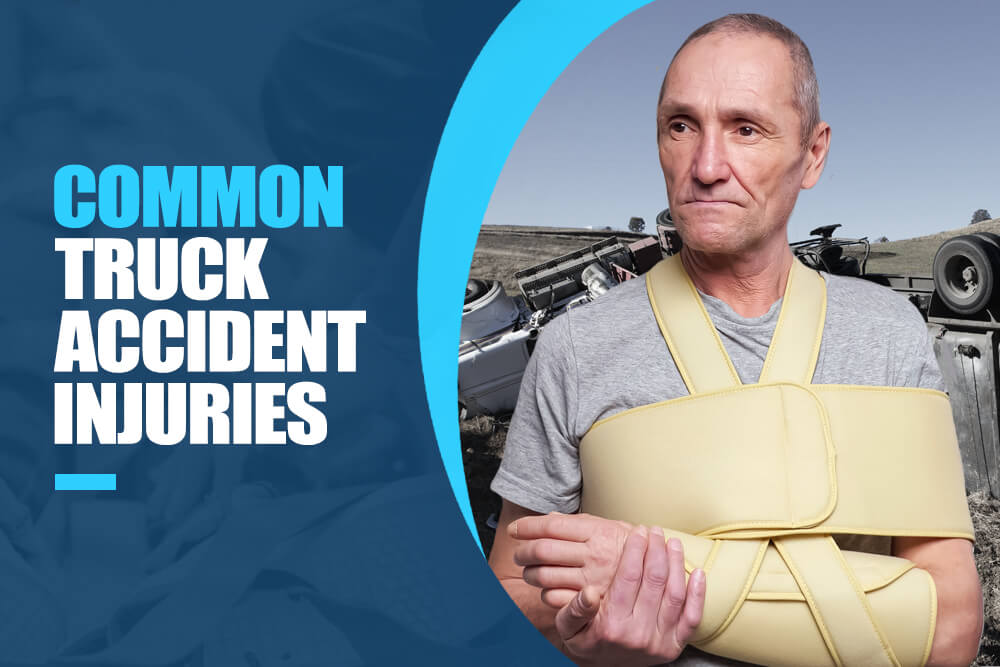Being involved in any type of truck accident has the potential to cause a wide range of injuries. However, crashes involving big rigs, tractor-trailers, and semi-trucks have a much higher likelihood of causing severe, catastrophic, and fatal injuries to those involved. No matter how safe of a truck driver you are, it’s crucial to be aware that you can still be injured in truck accidents caused by negligent truck drivers or other negligent parties.
These types of occurrences are more frequent than many people realize. Statistics from the Florida Highway Safety and Motor Vehicles revealed that nearly 32,000 accidents involving large trucks occurred in Florida in 2017. Of these accidents, 27 people were killed, 57 were incapacitated, and 1,053 suffered other injuries. Truck accidents can happen due to a variety of situations, including
● Speeding
● Fatigued driving,
● Drunk or impaired driving,
● Distracted driving,
● Reckless driving,
● Poor vehicle maintenance,
● Improperly loaded cargo
How Often Do Truck Accidents Result In Serious Injury?
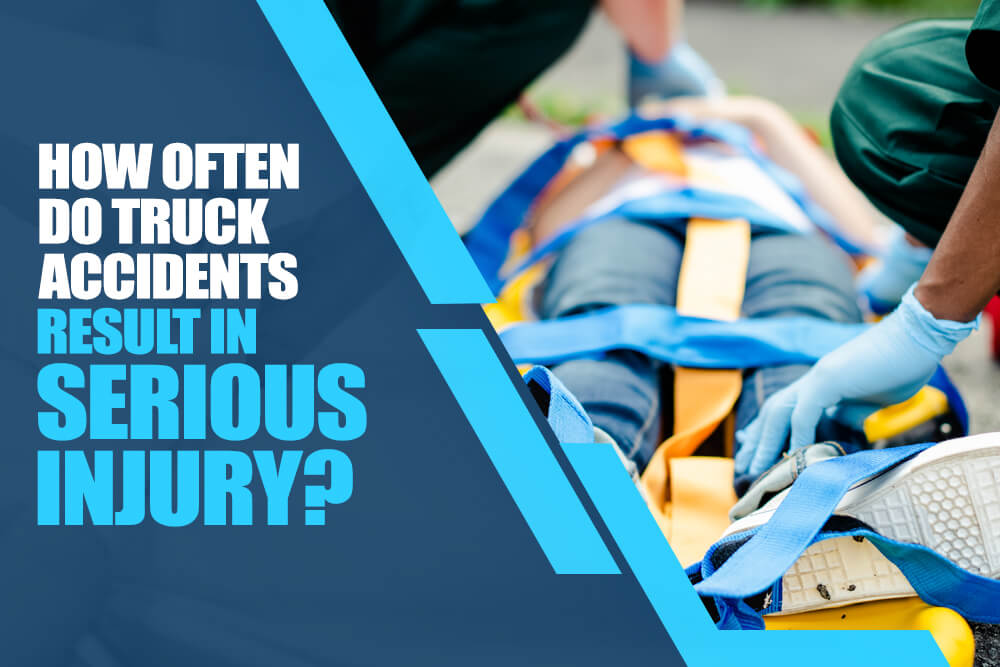
As you can imagine, a fully loaded tractor-trailer weighing 80,000 pounds will easily cause more severe damage to a 6,000-pound-passenger vehicle. The weight of a truck often means that those in passenger vehicles are more likely to be injured in crashes involving big trucks since commercial truck drivers themselves have more physical protection around them and less force hitting them from an impact.
The type and severity of injury resulting from a truck crash will vary based on many factors, including the size of the truck, how fast the vehicle was moving, how the cargo was loaded, and the type of cargo that was loaded.
Common Minor Truck Accident Injuries
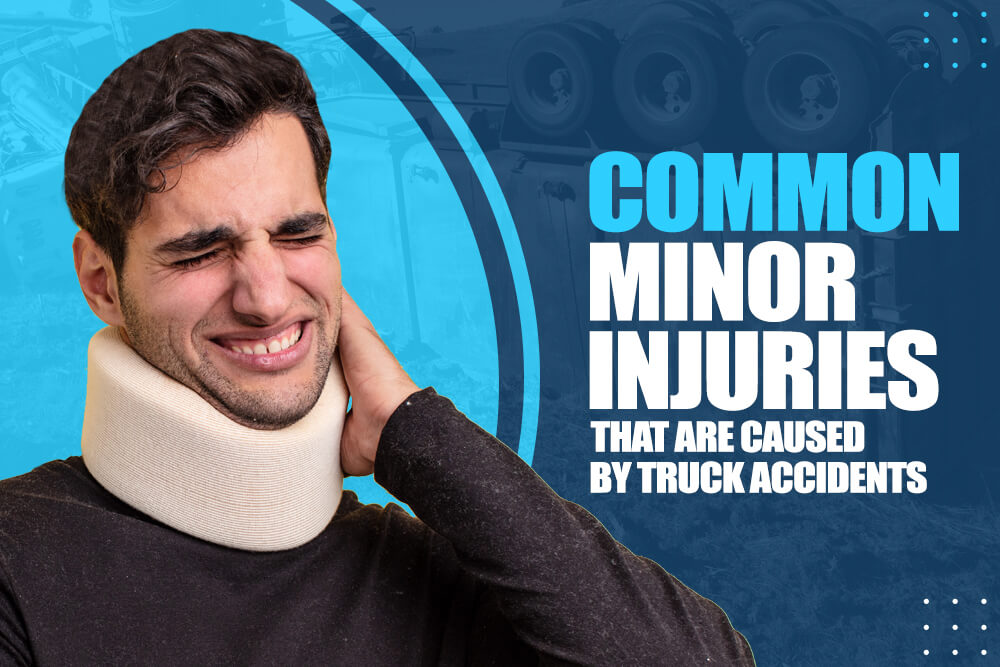
Truck accident-related minor injuries often occur if the truck doesn’t directly come in contact with a vehicle occupant’s car. For instance, if a multi-vehicle pileup occurs due to a truck accident, minor injuries may result from cars being hit by other moving or swerving vehicles. Minor injuries may occur on their own or in addition to more serious ones.
It is crucial to keep in mind that not all severe injuries show symptoms immediately. Even if you believe you only sustained minor injuries in a truck accident, you should never attempt to diagnose yourself and always seek medical treatment. This way, you can protect your health and rights to potential future compensation.
With that said, here are some common minor injuries that occur from a truck collision
Whiplash & Neck Injuries
Whiplash is a neck injury that occurs when the head is suddenly jerked backward and forward violently and involves the neck’s muscles, discs, and tendons. Some of the most common symptoms include neck stiffness, shoulder pain, lower back pain, dizziness, pain in the arm or hand, numbness in the arm or hand, and ringing in the ears. Other neck injuries include local soft tissue damage, ligament strains, lacerations, or herniated discs.
While whiplash is considered a minor injury, it can impact an individual’s ability to perform their day-to-day activities. It may require medical treatment in the form of muscle-relaxing medications, physical therapy, and more.
Most whiplash symptoms are typical after minor truck accidents, including slow-moving collisions.
Fractures & Broken Bones
There are many ways that a truck accident can lead to a fracture or broken bone, which are some of the most common injuries from these crashes. For instance, a vehicle occupant hit by a truck may hit the dashboard or be crushed by the sheer force of the impact. This injury can occur to virtually any bone, including legs, arms, hips, ribs, clavicles, fingers, and wrists.
Signs of a broken bone include swelling, bruising, the inability to move that part of the body, the inability to put weight on that part of the body, and unusual bending of a body part. A skull fracture may also occur, which involves cranial bone breaking and can lead to brain bleeds or infections.
A broken bone is painful; most people will know instantly when it happens. However, the adrenaline pumping through your body may mask the pain after a crash. There are different types of fractures based on severity. A stable fracture occurs when the bone breaks but is lined up and heals more readily. A compound fracture is often more painful and difficult to heal.
The recovery time and treatment needed for a fracture will depend on the type of fracture sustained, the location of the break, whether any other injuries were sustained, and other factors. Most fractures will heal in 6-8 weeks. However, some breaks require surgery, and long-term impairments may result. Some broken bones can put individuals out of work while recovering or attending essential doctor’s appointments, leading to lost wages. This can take a toll on the individual’s home and family, especially if this person is the necessary contributor for bills and finances.
Burns, Cuts & Bruising
Fast-spreading, high-temperature fires may result from truck accidents and can lead to burns, as can road rash in which vehicle occupants are dragged across abrasive pavement. Most truck accident-related burns are first-degree, affecting the outer layer of skin, and second-degree, affecting the outer layer and second layer of skin. These injuries often heal by themselves but may require doctors to clean the affected area to prevent infections in the open wounds. Third-degree burns, however, are not minor injuries and may result in scarring, extreme pain, and disfigurement and require skin grafts and infection prevention treatments. These burns can occur if vehicle occupants become trapped inside the vehicle.
Cuts and lacerations are also not considered severe injuries in most cases. However, they are one of the most common truck accident injuries and often require some sort of treatment. When a sharp object breaks through the skin, it could lead to bleeding and leave the skin open, risking infection to the body. This can occur if, for instance, glass from the windshield or windows breaks into shards and cuts vehicle occupants. Some cuts may be extremely painful and deep enough to require stitches and leave permanent scars. Individuals who sustain permanent scars due to lacerations may be entitled to compensation for emotional damages, especially if the scars are located in a noticeable area, like the face, neck, or hands.
Bruising is another common type of minor injury that can occur after a truck accident. Bruises occur when blood gathers under the skin due to trauma, such as a heavy force. They can be extremely painful if they cover large portions of the body but ultimately will heal on their own. Serious bruising can negatively impact one’s quality of life weeks after a truck accident because moving around can be extremely painful. While most bruises themselves are harmless, they can indicate a more serious complication or more serious forms of bruising, such as contusions or hematomas.
Common Injuries From Trucking Accidents
Because trucks are bigger, they inherently cause more physical damage and have a higher chance of causing severe injuries compared to regular car accidents. Severe or catastrophic injuries are essentially considered ones that have a considerable impact on the victim and require a considerable amount of medical treatment, potentially even life-saving treatment. They may or may not be permanent and often result in pain and emotional suffering. Some of the most common types of severe injuries sustained in truck accidents include the following:
Internal Trauma & Damage
Internal injuries can be life-threatening because they often do not produce symptoms to warn injury victims that their lives are in jeopardy. Organs like the spleen, liver, pancreas, kidneys, and gallbladder may become injured in large truck crashes but may produce the same red swelling that occurs from external injuries. In order to diagnose and treat these types of internal injuries, a doctor or medical expert will have to perform some sort of tests like an X-ray, CT scan, or angiography to examine all the internal tissues, bones, and blood vessels.
While wearing a seatbelt can reduce the risk of serious or fatal injury in vehicle crashes, wearing one improperly can actually lead to these types of internal injuries because the body is projected against the seat belt, potentially injuring the bowels, heart, spleen, liver, and lungs. Internal bleeding is another type of serious, life-threatening injury caused by trucking accidents and occurs when blood vessels in the body are damaged or severed, and the body cannot blood clot. This can lead to symptoms of confusion, weakness, disorientation, feeling cold, bloody vomit, bruising, or trouble breathing. Internal bleeding that is not caught and treated properly can lead to organ failure and death.
Spinal Cord Injuries
Injuries that occur to the spine or back are often severe and lead to devastating impacts. Spinal cord injuries may occur when a vehicle occupant hits a large object with force or is pushed or thrown in a way that causes the spinal cord to snap or vertebrae to break. This type of injury can then leave individuals as paraplegic, which is paralysis of the legs and lower body, or quadriplegic, which is paralysis of the legs and the arms. Victims may lose the ability to breathe on their own, lose the ability to walk, and suffer from pressure sores and other types of conditions in the future.
These types of injuries can negatively impact one’s quality of life and increase the risk of depression. Lost income may occur if these individuals cannot return to doing the work they performed before the injury. It is often a permanent injury and requires lifelong medical treatment and other assistance that can cost many millions of dollars over the course of a lifetime.
A number of other back injuries may result from a large truck accident. The lumbar vertebrae ( upper back), the thoracic vertebrae ( upper back), and the cervical vertebrae (neck) all consist of a complex connection of tissues, nerves, ligaments, bones, tendons, and muscles. Damage to any of these body parts can lead to chronic pain. Other symptoms that may arise include muscle spasms, tingling, numbness, or discomfort. Soft discs also sit in between each vertebra for cushioning and can become herniated as well, leading to extreme radiating pain.
Concussions & Traumatic Brain Injuries
Traumatic brain injuries (TBI) are considered catastrophic injuries and can have lifetime ramifications for truck accident victims. A TBI occurs due to a sudden bump, jolt, or blow to the head. Immediately, a person may be confused, not remember what just occurred, have blurry vision, or lose consciousness. These types of injuries may occur if a vehicle occupant slams against the dashboard, hits objects inside of the vehicle, or has projectiles slam against the skull resulting from the crash.
A concussion is considered a mild traumatic brain injury and may result in headaches, temporary memory loss, balance issues, and concentration issues. They often heal within two months. A moderate TBI is one in which the symptoms last six months to one year. A severe TBI is one where symptoms are long-lasting and may result in permanent brain damage, including emotional problems. Those who sustained TBI in truck accidents are entitled to compensation to make up for what they have experienced. Compensation may be awarded to help these individuals with the trauma they have experienced and difficulties they may face in the future.
What To Do After a Truck Accident Injury
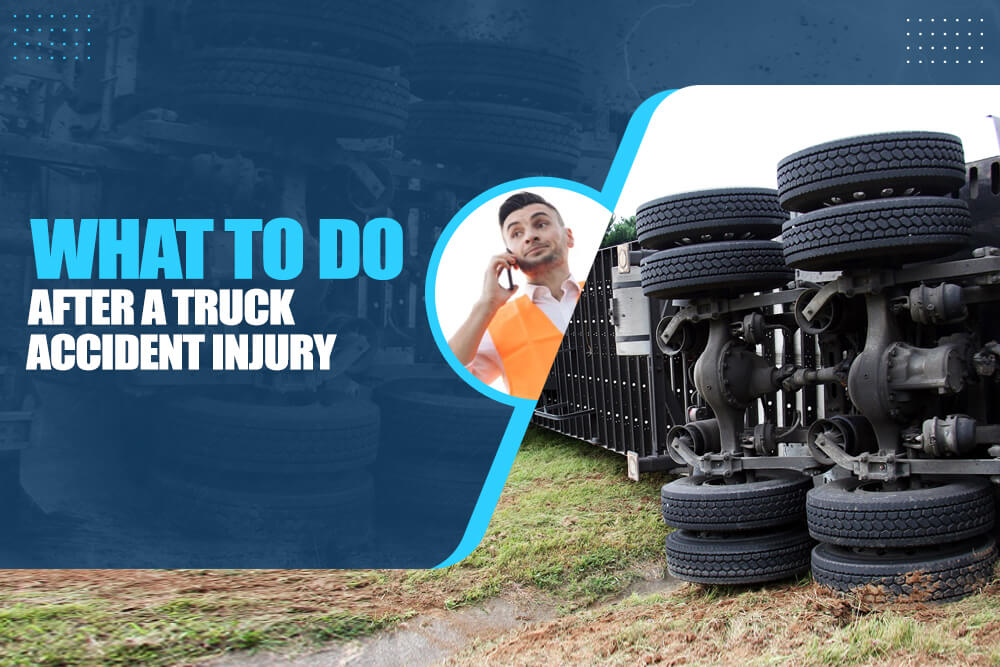
- If you are injured after a collision, call 911 immediately. If you are incapacitated, someone would likely have already called 911 during a major accident. Most new cars have accident detection systems like OnStar, BMW Connected Drive, etc, which will call emergency services for you.
- If you can, take pictures of the accident scene,make that your second priority after calling for help. Make sure to document the following.
- Weather
- Images of the crash
- Exact time & Location. Use your phone’s GPS to document exact coordinates and names when taking pictures.
- Write down as much information about the accident as possible.
- Keep a quick record of your injuries. For example, what parts of your body have lacerations or bruising? Do you have injuries from glass or blunt trauma?
- Never admit fault to the driver or their insurance company. Let the investigation take place and the facts of your accident examined.
- If your car is totaled and you are injured, it’s best to contact a local law firm to help you navigate your options and protect your interests. After contacting your insurance company, start interviewing personal injury lawyers specializing in truck accident cases.
Contact Florida’s Most Trusted Truck Accident Lawyer Today!
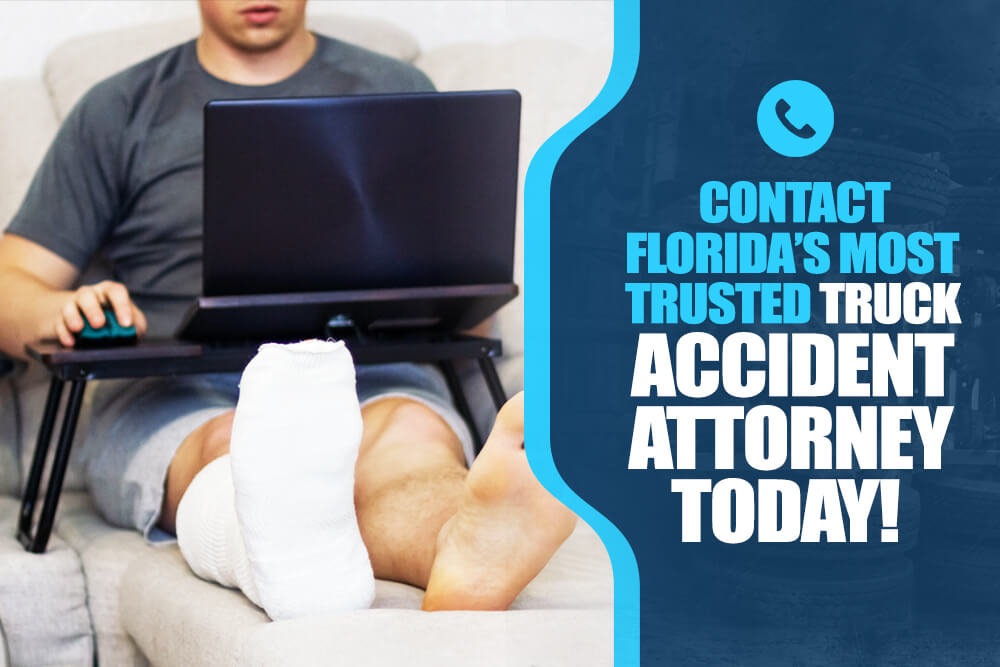
Spending monetary money on your health, safety, and future is hard. If you have been injured in a truck accident in Florida, we recognize that there may be no amount of money that can compensate for the trauma, pain, and emotional turmoil you have experienced. However, our law firm believes in holding responsible parties accountable for what you have experienced and helping you obtain justice and maximum compensation to help get your life back on track after a truck accident.
If you are injured, our team of experienced accident lawyers will help you and your family seek the maximum compensation allowed by law for your truck accident injuries.
● Medical expenses
● Future medical treatment
● Lost wages
● Lost warning capacity,
● Emotional injuries
● Pain and suffering,
● Lost quality of life.
Let us be your voice and fight for you. Contact the Florida truck accident attorneys at Schrier Law Group for a free consultation today.




